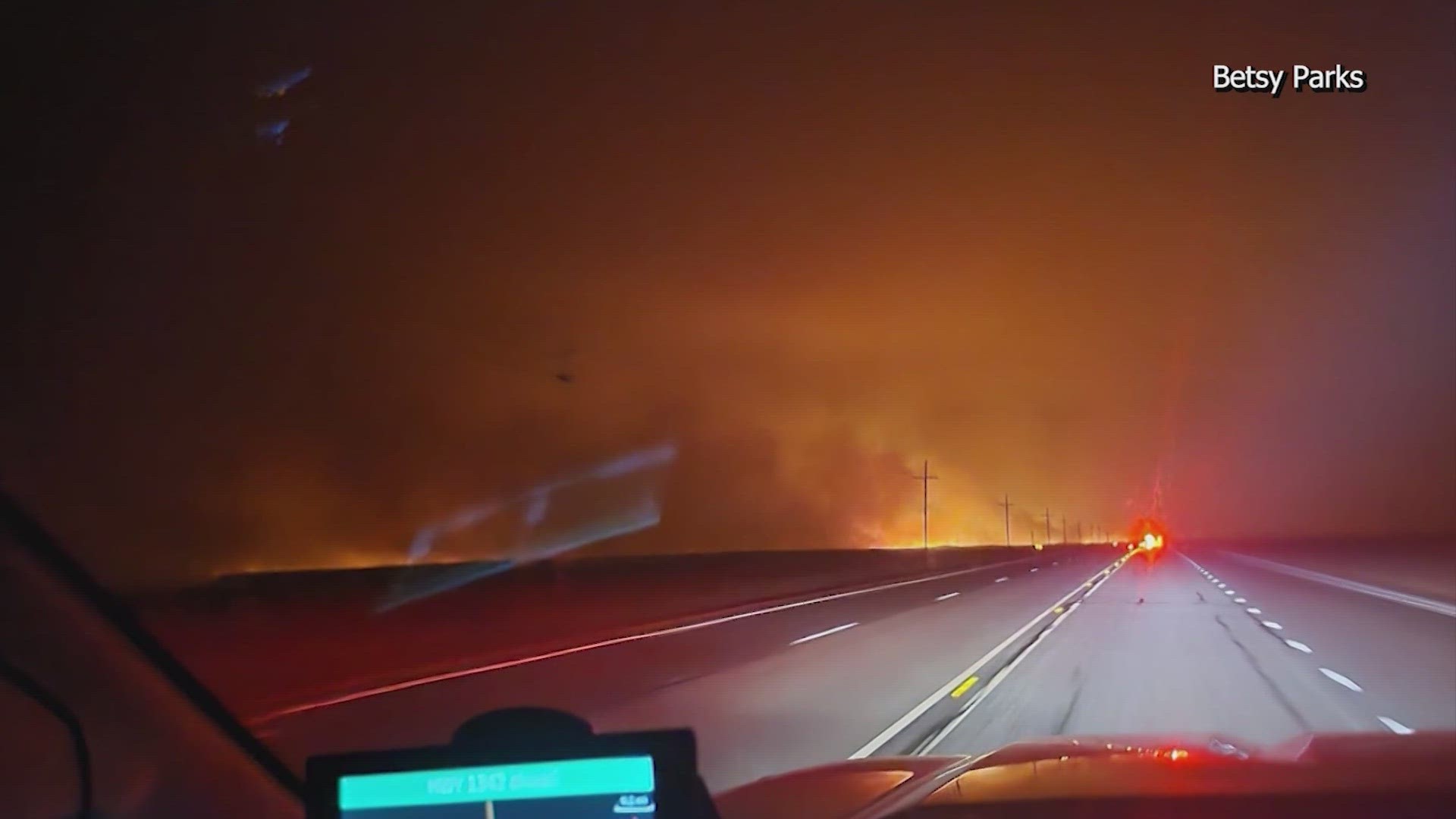TEXAS, USA — A cluster of wildfires scorched the Texas Panhandle on Wednesday, including a blaze that grew into one of the largest in state history, as flames blackened the landscape across a vast stretch of small towns and cattle ranches.
Authorities warned that the damage to communities on the high plains could be extensive. Strong winds, dry grass and unseasonably warm temperatures fed the blazes.
The largest fire — which expanded to nearly 800 square miles (2,072 square kilometers) — jumped into parts of neighboring Oklahoma and was completely uncontained as dawn broke, according to the Texas A&M Forest Service.
Authorities had not reported any deaths or injuries as of Wednesday morning while huge plumes of smoke billowed hundreds of feet in the air. But officials warned residents of potentially large property losses.
Hemphill County Emergency Management Coordinator Bill Kendall described the charred terrain as being “like a moonscape. ... It's just all gone.”
Kendall said about 40 homes were burned around the perimeter of the town of Canadian, but no buildings were lost inside the community.
“We started getting those losses in the dark, so we didn’t really know what we had until this morning, until we could see,” he said.
The town of Fritch, with a population of less than 2,000, lost hundreds of homes in a 2014 fire and appeared to be hit hard again.
The people in that area are probably not "prepared for what they’re going to see if they pull into town,” Hutchinson County Emergency Management spokesperson Deidra Thomas said in a social media livestream. She compared the damage to a tornado.
The town remained unsafe for people to return, she said.
Tresea Rankin videotaped her own home in the town of Canadian as it burned.
“Thirty-eight years of memories, that’s what you were thinking,” Rankin said of watching the flames destroy her house. “Two of my kids were married there ... But you know, it’s OK, the memories won’t go away.”
Near Borger, a community of about 13,000 people, emergency officials at one point late Tuesday answered questions from panicked residents on Facebook and told them to get ready to leave if they had not already.
“It was like a ring of fire around Borger. There was no way out ... all four main roads were closed,” said Adrianna Hill, 28, whose home was within about a mile of the fire. She said a northern wind that blew the fire in the opposite direction “saved our butts.”
The blazes tore through sparsely populated counties on the vast, high plains that are punctuated by cattle ranches and oil rigs. The main fire, known as the Smokehouse Creek Fire, had grown to more than half the size of the state of Rhode Island. It is five times larger than on Monday, when it began.
The weather forecast provided some hope for firefighters — cooler temperatures, less wind and possibly rain on Thursday. But for now, the situation was dire in some areas.
Sustained winds of up to 45 mph (72 kph), with gusts of up to 70 mph (113 kph), caused the fires that were spreading east to turn south, threatening new areas, forecasters said. But winds calmed down after a cold front came through Tuesday evening, said Peter Vanden Bosch, a meteorologist at the National Weather Service in Amarillo.
“Fortunately, the winds have weakened quite significantly,” Vanden Bosch said Wednesday. Breezy conditions were expected again Friday, and fire-friendly weather could return by the weekend, he said.
As the evacuation orders mounted Tuesday, county and city officials implored residents to turn on emergency alert services on their cellphones and be ready to evacuate immediately.
The Pantex plant, northeast of Amarillo, evacuated nonessential staff Tuesday night out of an “abundance of caution,” said Laef Pendergraft, a spokesperson for National Nuclear Security Administration’s production office at Pantex. Firefighters remained in case of an emergency.
The plant has long been the main U.S. site for both assembling and disassembling atomic bombs. It completed its last new bomb in 1991 and has dismantled thousands since.
Pantex tweeted early Wednesday that the facility “is open for normal day shift operations” and that all personnel were to report for duty according to their assigned schedule.
Republican Gov. Greg Abbott issued a disaster declaration for 60 counties. The encroaching flames caused the main facility that disassembles America’s nuclear arsenal to pause operations Tuesday night, but it was open for normal work on Wednesday.
The Houston Fire Department and departments across Texas sent crews to the Panhandle to help fight the wildfires.

